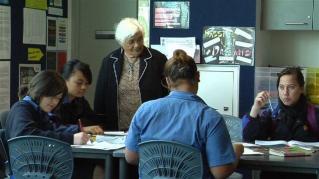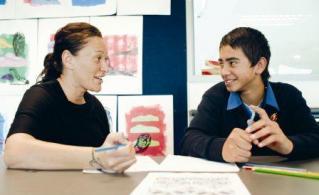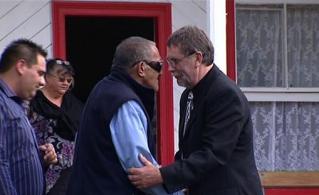Section navigation
The Taihape Area School case studies are part of the Te Kauhua case studies report (2010), prepared for the Ministry of Education by Dr Ruth Gorinski. As part of their action research for Te Kauhua phase 3, Taihape Area School undertook two projects. For Project 1 they investigated what really makes a difference for Māori student achievement outcomes within a ‘place based’ educational context. Project 2 involved the collaborative development of e-portfolios to engage whānau in the student learning partnership.
Background
Taihape Area School (TAS) is a decile four, year 1-13 school with a roll of 404 students of which 60% identify as Māori. The school has been involved in the Te Kauhua initiative since 2005.
Research Question
Taihape Area School worked on two research projects. The first of these was the development of a Mōkai Patea curriculum. The specific question that underpinned this research was: What really makes a difference for Māori student achievement outcomes within a ‘place based’ educational context?
Impetus for the initiative
The impetus for the initiative arose from an expressed desire by whānau and iwi for a place based curriculum. Both whānau and iwi wanted the opportunity to be involved in defining how each of the curriculum vision areas - confident, connected, actively involved, lifelong learners - relates and is dependent on that which comes from ‘te ao Maori’ and more specifically Mokai Patea.
To initiate the process, Mōkai Patea Iwi accepted a tono from TAS to develop a framework and structure for productive partnerships. The intention was to consolidate iwi endorsed Mokai Patea knowledge, skills, and attitudes within the TAS curriculum and create a process that was transferable to other schools.
What was done?
TAS and Iwi worked together to co-construct a Mōkai Patea curriculum. The focus was on teachers building their knowledge of tikanga so they could affirm Māori students' culture and support their learning and success. Iwi and whānau wanted the local context to be embedded in students' learning.
Staff learned alongside whānau - in the true spirit of ako – to create a curriculum that was reflective of four Māori values that reflect the key competencies in the curriculum. These tikanga or values included:
Rangatiratanga: self affirmation, efficacy, the characteristics of the leader - in order to increase leadership opportunities
Manaakitanga: acknowledging, affirming stakeholders - in order to strengthen relationships
Whānaungatanga: a team approach, shared roles and responsibilities – in order to plan succession
Wairuatanga: acknowledging the spirit behind the face/action – in order to build intrinsic motivation
Te Reo: This was identified as being ‘te mauri o te mana Māori.’ It was acknowledged that building te reo capability would affirm “Mōkai Patea-tanga” and Māori-tanga.
Iwi, whānau, and the school agreed to develop the curriculum through two major initiatives: Te Ara Pounamu and wananga. Te Ara Pounamu was a whole school production that involved the development of shared understandings of the four values, and the collective pursuit of actions that would see them reflected across all levels of the school.
Iwi-whānau-staff two day wananga were held at local marae. Staff learned about mana whenua, local history, tupuna, and landmarks, as well as about the four Māori values and their impact upon tikanga. Participants learnt waiata and mihi and Iwi tutors worked with staff to develop programmes and resources that supported whānau and teacher learning throughout the wananga. This professional learning enabled all contributors to the Mōkai Patea curriculum to develop shared understandings and learnings.
What was the impact on student learning and achievement?
- PAT math data reveal a positive shift for Māori learners. For example, Year 4 Māori student data reveal significant shifts in the numbers of learners progressing up stanine levels [1].
| Year 4 Māori students |
|
| Term 1 | Term 4 |
| 33 % critically below | 8 % critically below |
| 42 % below | 50 % below |
| 25 % at | 17 % at |
|
| 25 % above |
- The number of Māori students achieving NCEA numeracy has increased dramatically.
| Year | 2006
| 2007
| 2008
| 2009
|
| 11 | 5% | 83% | 70% | 96% |
| 12 | 35% | 64% | 93% |
|
| 13 | 22% | 29% | 80% |
- Teachers reported positive changes in student behaviour and higher levels of student engagement. They attributed this to students having an increased sense of purpose about what they are learning.
- Students in junior classes exemplify a sense of pride in who they are as Māori. There is evidence of increased te reo Māori korero.
Key learning
- Open discussion about values/tikanga and reflection upon personal values and beliefs, is a starting point for mutual understanding amongst staff, whānau, and iwi in building a locally contextualised curriculum.
- For whānau and iwi to be active contributors to the educational partnership, leaders must ensure that the school curriculum reflects the values of iwi and tangata whenua.
- On-going teacher and leadership professional learning is necessary to maximize Māori learner success. Noho marae/wananga with staff, whānau, and iwi are useful mechanisms for fostering cultural understandings.
- High expectations for student achievement and the notions of ‘excellence’ and ‘curriculum coherence’ are promoted through: changes to curriculum structure and timetabling; learner-centred programme design that promotes concepts rather than contexts and development of greater subject choice for students.
- A locally contextualised curriculum provides multiple opportunities for manaakitanga, whānaungatanga, wairuatanga and te reo Māori to be embedded in classroom practice and the wider school culture.
- A co-constructed curriculum provides opportunities for open communication and participation by teachers, students, parents, whānau, and iwi in decision making around learning and teaching. Stakeholder confidence and ownership of outcomes are facilitated when curriculum development processes are transparent and shared.
Challenges and opportunities
- Schools need to recognise that iwi maintain rangatiratanga (ownership) over any knowledge shared in the process of localised curriculum development. They have the right to disallow the use of any cultural resource or knowledge, should misuse or culturally unsafe practice occur.
- Ensuring adequate and appropriate support is given to teachers, ancillary staff, BOT members, and whānau who have little or no experience of Māori tikanga, when planning noho marae.
Reflective questions
- What do you as a teacher know about the school community in which you work?
- Does teacher knowledge about the community the school serves make any difference to student learning?
- Assuming that teacher knowledge about the local community does make a difference to student learning, what sorts of knowledge are the most valuable? Why?
- How can a relationship between school whānau and iwi be initiated and maintained in your community?
- How can a school negotiate a co-constructed curriculum when there are multiple iwi in the community?
- What are the pre-conditions to establishing productive partnerships with whānau and iwi?
- What factors might weaken or break a relationship?
- What are the indicators of an effective partnership?
- How can school leadership motivate and encourage perseverance amongst staff in pursuit of increased understanding of tikanga and te reo Māori?
[1] Common Scale (Stanines) New Zealand Council of Education Research : Outstanding Stanine 9 Above Average Stanine 7 – 8, Average Stanine 4 – 6, Below Average Stanine 2 – 3, Low Stanine 1
Filed under: Productive partnerships | Effective teachers





